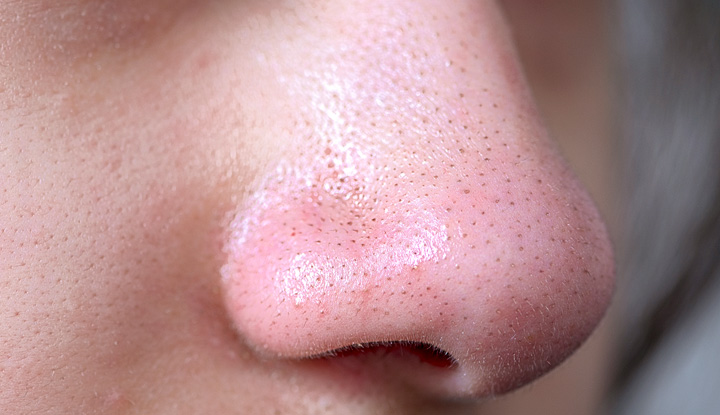Sebaceous filaments help move oil from your sebaceous glands to the surface of your skin. They sometimes look large and can be confused for blackheads, but they help keep your skin hydrated. Age, skin care and the thickness of hair follicles determine how noticeable they are.

Sebaceous filaments are thin, threadlike appendages that line your sebaceous (oil) glands. They help move an oily lubricant called sebum from the glands to the surface of your skin. When your sebaceous glands overproduce sebum, your sebaceous filaments become more noticeable.
Cleveland Clinic is a non-profit academic medical center. Advertising on our site helps support our mission. We do not endorse non-Cleveland Clinic products or services. Policy
Sebaceous filaments are a normal, healthy element of your skin. They help sebum travel to the surface of your skin. Sebum helps keep your skin and hair hydrated and shiny.
Sebaceous filaments look similar to blackheads, but they’re not the same.
Blackheads are a type of acne. They’re open, dark-colored bumps on the surface of your skin that fill with excess oil and dead skin. In a blackhead, a plug of sebum is at the surface of your skin. The plug prevents oil from traveling through the pore.
Sebaceous filaments aren’t a type of acne. They don’t have plugs, so oil travels freely to the surface of your skin.
Blackheads look like a dark speck of dirt is in a bump on your skin. Obvious sebaceous filaments look like dark spots on your skin, but they’re usually smaller, flat and lighter in color — typically, gray, light brown or yellow.
If you squeeze sebaceous filaments out from your skin, a waxy, threadlike structure may pop out of your pore. If you squeeze blackheads out from your skin, the dark, waxy plug may pop out of your pore.
Sebaceous filaments may be more obvious as a result of:
Every person has sebaceous filaments. If your body is overproducing oil or your skin is starting to loosen, your sebaceous filaments may look more noticeable.
Sebaceous filaments are most apparent around your face (especially your nose, forehead, chin and cheeks). However, oil glands are all over your body, so sebaceous filaments sometimes appear on your arms, legs, chest and breasts.
Sebaceous filaments may look like blackheads close up, but their presence is normal on your skin. They’re small, flat, light-colored spots on your skin. They don’t hurt or feel uncomfortable.
No, sebaceous filaments aren’t contagious.
Sebaceous filaments are easy to recognize, so you don’t necessarily need a healthcare professional to diagnose them. If you have sebaceous filaments along with other severe forms of acne, see a dermatologist for treatment. Dermatologists are doctors who specialize in conditions that affect your skin, hair and nails.
You can’t get rid of sebaceous filaments, but you can make them smaller by following a skin care routine that includes:
If you squeeze sebaceous filaments, a waxy, threadlike structure may pop out of your pore. However, you may not squeeze anything out, or you may squeeze out a tiny amount of oil.
You should avoid squeezing your sebaceous filaments. Sebaceous filaments are natural, and if you manage to squeeze out sebum, your pores will fill up again within 30 days. Your skin is sensitive, and your nails are much stronger than your skin. When you use your nails to apply a lot of pressure to your skin to remove sebaceous filaments, you can irritate or seriously damage your skin.
Pore strips are supposed to remove blackheads, but they can also remove sebaceous filaments. Sebaceous filaments are important in keeping your skin hydrated. Removing them can dry out your skin and permit bacteria into your skin that can cause acne. Be careful when using pore strips so you don’t remove your sebaceous filaments.
You’ll always have sebaceous filaments. If you don’t like the way they look, there are some things you can do to minimize them and prevent other skin issues:
Sebaceous filaments aren’t acne and they don’t cause harm. They keep your skin and hair healthy.
If you don’t like the way your sebaceous filaments look, you can take steps to regulate oily skin and minimize them.
See a healthcare provider if you can’t minimize the appearance of your sebaceous filaments with over-the-counter products and a proper skin care routine. They can prescribe stronger medications that decrease the amount of oil your body produces, minimizing your sebaceous filaments.
A note from Cleveland Clinic
Sebaceous filaments are an important part of your body, but don’t hesitate to contact your healthcare provider if you think they’re too big or you think there’s something wrong with your skin. You should take care of your skin and be aware of any changes. You know your body best, but your healthcare provider can properly diagnose any signs or symptoms and offer the best treatment options.
Last reviewed by a Cleveland Clinic medical professional on 01/04/2023.
Learn more about our editorial process.
Cleveland Clinic is a non-profit academic medical center. Advertising on our site helps support our mission. We do not endorse non-Cleveland Clinic products or services. Policy